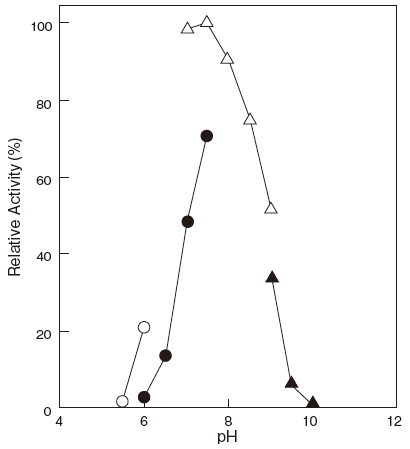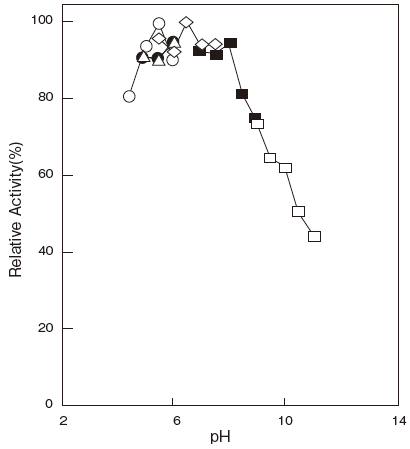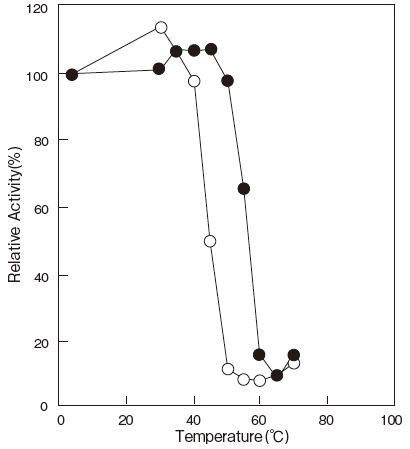Preparation and Specification
- Appearance
- : White to brownish amorphous powder,lyophilized
- Specific activity
- : More than 400 U/mg solid
Properties
- Substrate specificity
- : See Table 1
- Molecular weight
- : 37.5 kDa (SDS–PAGE)
- Isoelectric point
- : pH 8.6
- Michaelis constants
- : Sphingomyelin 0.45 × 10–3M
- Optimum pH
- : 7.0–8.0Figure 1
- pH stability
- : 5.0–8.0 (37℃, 60 min) Figure 2
- Thermal stability
- : Stable at 40℃ and below (pH7.2, 10 min) Figure 3
- Storage stability
- : At least one year at −20℃
- Effect of detergents
- : See Table 2
- Effect of metal ions
- : See Table 3
- Stabilizer
- : Mg2+
- Activator
- : Mg2+, Mn2+, Non–ionic detergents
- Inhibitor
- : EDTA
Applications for Diagnostic Test
This enzyme is useful for enzymatic determination of sphingomyelin when coupled with alkaline phosphatase (T−08) and choline oxidase (T−05) .
| SPC | ||
| Sphingomyelin + H2O | → | Ceramide + Phosphorylcholine |
| ALP | ||
| Phosphorylcholine + H2O | → | Choline + H3PO4 |
| COD | ||
| Choline + 2 O2 + H2O | → | Betaine + 2 H2O2 |
| POD | ||
| 2 H2O2 + 4-AA + Phenol | → | Quinoneimine dye + 4 H2O |
Table 1. Substrate specificity
| Substrate | Relative activity (%) |
|---|---|
| Sphingomyelin | 100 |
| Lecithin | 0 |
| Lysolecithin | 0 |
| Phosphatidylethanolamine | 0 |
| Phosphatidylserine | 0 |
| Phosphatidylinositol | 0 |
Table 2. Effect of detergents on SPC activity
| Detergent (0.1%) |
Relative activity (%) |
|---|---|
| None | 100 |
| Adekatol NP-700 | 335 |
| Adekatol PC-8 | 426 |
| Adekatol SO-145 | 367 |
| Pluronic L-61 | 267 |
| Triton X-100 | 358 |
| Sodium deoxycholate | 0 |
| Sodium lauryl sulfate | 0 |
| Sodium lauryl benzene sulfonate | 0 |
Table 3. Effect of metal ions on SPC activity
| Metal (2 mM) |
Relative activity (%) |
|---|---|
| None | 2 |
| MgCl2 | 97 |
| MgSO4 | 97 |
| MnCl2 | 100 |
| CoCl2 | 39 |
| NiCl | 6 |
| CaCl2 | 3 |
| Na2MoO4 | 1 |
| ZnSO4 | 1 |
Assay
Principle
-
The assay is based on the increase in absorbance at 540 nm as the formation of dye in the following reactions:
| SPC | ||
| Sphingomyelin+H2O | → | Ceramide+ Phosphorylcholine |
| ALP | ||
| Phosphorylcholine+H2O | → | Choline+H3PO4 |
| COD | ||
| Choline+2O2+H2O | → | Betaine+2 H2O2 |
| POD | ||
| 2 H2O2+4–AA+TODB | → | Dye+4 H2O |
Unit definition
-
One unit is defined as the amount of enzyme which hydrolyzes 1 μmole of sphingomyelin per minute at 37℃ under the conditions specified in the assay procedure.
Reagents
- Reaction mixture
0.2 M Tris–HCl buffer pH 8.0 0.25 ml 10 mM MgCl2 solution 0.20 ml 6 mM Sphingomyelin solution 1) 0.10 ml 500 U/ml ALP solution 2) 0.02 ml 120 U/ml COD solution 3) 0.084 ml 100 U/ml POD solution 4) 0.02 ml 0.2 % 4–AA solution 0.10 ml
-
0.2 % TODB solution 0.10ml 1.0 M NaCl solution 0.01ml 1 % (W/V) Triton X–100 solution 0.10ml Distilled water 0.016ml 1) : 6 mM Sphingomyelin solution
Dissolve 42.2 mg of sphingomyelin with 10 ml of 5% (W/V) Triton X–100.2) : 500 U/ml ALP solution
Dissolve 5000 U of ALP with 10 ml of 10 mM Tris–HCl buffer pH 9.0.3) : 120 U/ml COD solution
Dissolve 1200 U of ALP with 10 ml of 10 mM Tris–HCl buffer pH 8.0.4) : 100 U/ml POD solution
Dissolve 1000 U of ALP with 10 ml of distilled water. - Enzyme dilution buffer
10mM Tris–HCl buffer pH 8.0 containing 0.1% (W/V)
TritonX–100 and 10 mM NaCl. - Reaction stopper
1.0% (W/V) SDS solution
SDS: sodium dodecyl sulfate - Reagents:
Tris (hydroxylmethyl) aminoethane: Sigma Chemical Co.# T–1503MgCl2・6H2O:FUJIFILM Wako Pure Chemical CorporationSpingomyelin: NOF Corporation # 308–17081
#131–00162
ALP: Asahi Kasei Pharma Corporation # T–08
COD: Asahi Kasei Pharma Corporation # T–05
POD: Sigma Chemical Co. Type Ⅱ #P–8250
4–AA: NACALAI TESQUE, INC. Special grade#01907–52TODB (N, N–Bis (4–sulfobutyl) –3–methylaniline, disodiumsalt) : Dojindo Laboratories #OC22NaCl: FUJIFILM Wako Pure Chemical Corporation#191–01665Triton X–100: The Dow Chemical Company
SDS: NACALAI TESQUE, INC. #316–06
Enzyme solution
Weigh about 20 mg of test sample exactly and add enzyme dilution buffer to make a Total of 20 ml. Dilute it with enzyme dilution buffer as required.
Procedure
- Pipette accurately 1.0 ml of reaction mixture into a small test tube and preincubate at 37℃.
- After 3 min, add 40 μl of enzyme solution and mix to start the reaction at 37℃.
※ In the case of a test blank add 40 μl of enzyme dilution buffer in place of enzyme solution. - At 10 min after starting the reaction, add 2.0 ml of the reaction stopper to stop the reaction.
- Measure the absorbance at 546 nm.
0.070Abs ≦ △A = ( As -Ab) ≦ 0.450AbsAbsorbance sample : As blank : Ab
Calculation
- Activity (U/mg) = {(△A/10)/(16.0×1/2)} × 1/2 × 3.04/0.04 × 1/x
-
16.0 : millimolar extinction coefficient of TODB at 546 nm (cm2/ μmole) 1/2 : a multiplier derived from the fact that 2 mole of H2O2 produces 1 mole of dye 2 : a multiplier derived from the fact that 1 mole of sphingomyelin produces 2 mole of dye 10 : reaction time (min) 3.04 : final volume (ml) 0.04 : volume of enzyme solution (ml) X : concentration of the sample in enzyme solution ( mg/ml)
Storage
-
Storage at −20℃ in the presence of a desiccant is recommended.
References
- Schneider, P. B. and Kennedy, E. P. (1967) J. Lipids Res., 8, 202-209.
- Yamaguchi, S. and Suzuki, K. (1977) J. Biol. Chem., 252, 3805-3813.
- Ikezawa, H., Mori, M., Ohyabu, T. and Taguchi, R. (1978) Biochem. Biophys. Acta, 528, 247-256.
- Pentchev, P. G., Brady, R. O., Gal, A. E. and Hibbert, S. R. (1977) Biochem. Biophys. Acta, 488, 312-321.
SPC 活性測定法 (Japanese)
試薬液
- 反応試薬混合液
0.2M トリス− HCl buffer pH8.0 0.25 ml 10mM 塩化マグネシウム溶液 0.20 ml 6mM スフィンゴミエリン溶液 1) 0.10 ml 500U/ml ALP 溶液 2) 0.02 ml 120U/ml COD 溶液 3) 0.084 ml 100U/ml POD 溶液 4) 0.02 ml 0.2% 4–AA 溶液 0.10 ml 0.2% TODB 溶液 0.10 ml 1.0M 塩化ナトリウム溶液 0.01 ml
-
1% (W/V) トリトンX–100 溶液 0.10 ml 精製水 0.016 ml 1) : 6mM スフィンゴミエリン溶液
スフィンゴミエリン42.2mg を 5% (W/V) トリトンX–100 溶液 10ml で溶解する。2) : 500U/ml ALP 溶液
ALP 5,000 単位 (U) を10mM トリス− HCl 緩衝液 pH9.0 10ml で溶解する。3) : 120U/ml COD 溶液
COD 1,200 単位 (U) を 10mM トリス− HCl 緩衝液 pH8.0 10ml で溶解する。4) : 100U/ml POD 溶液
POD 1,000 単位 (PPU) を精製水 10ml で溶解する。
- 酵素溶解希釈用液
0.1% TritonX–100 と10mM NaCl を含む10mM
トリス− HCl 緩衝液 pH8.0 - 反応停止液
1.0% (W/V) SDS 溶液
SDS: ドデシル硫酸ナトリウム - 試薬
トリス (ヒドロキシメチル) アミノメタン:シグマ製 #T–1503塩化マグネシウム:富士フイルム和光純薬製#131–00162スフィンゴミエリン:日油製 #308–17081
ALP : 旭化成ファーマ製 #T–08
COD : 旭化成ファーマ製 #T–05
POD : シグマ製 Type Ⅱ #P–8250
4–AA : ナカライテスク製 特級 #01907–52
TODB (N,N–Bis (4–sulfobutyl) –3–methylaniline,
disodium salt) :同仁化学研究所製 #OC22
塩化ナトリウム:富士フイルム和光純薬製#191–01665Triton X–100:Dow Chemical 製
SDS:ナカライテスク製 #316–06
酵素試料液
- 検品約20mg を精密に量り、酵素溶解希釈用液で溶
解して全容20ml とする。
その液を酵素溶解希釈用液で適宜希釈する。
測定操作法
- 小試験管に反応試薬混合液 1.0ml を正確に分注し、37℃で予備加温する。
- 3 分経過後、酵素試料液 40 μl を正確に加えて混和し、37℃で反応を開始する。
※ 盲検は酵素試料液の代わりに酵素溶解希釈用液40 μlを加える。 - 10 分経過後、反応停止液2.0ml を加えて混和し、反応を停止する。
- 546nm における吸光度を測定する。
求められた吸光度を試料液については As
盲検液については Ab とする。
0.070 Abs. ≦ΔA = (As-Ab) ≦ 0.450 Abs
計算
活性 (U/mg) = {(△A/10)/(16.0×1/2)} × 1/2 × 3.04/0.04 × 1/x| 16 : | TODB の546nm におけるミリモル分子吸光係数 (cm2 / μmole) |
| 1/2 : | H2O2 2 モルから 色素 1 モルが生成することによる係数 |
| 2 : | スフィンゴミエリン1 モルからH2O2 2 モルが生成することによる係数 |
| 10 : | 反応時間 (min) |
| 3.04 : | 反応総液量 (ml) |
| 0.04 : | 反応に供した酵素試料液量 (ml) |
| X : | 酵素試料液中の検品濃度 (mg/ml) |






